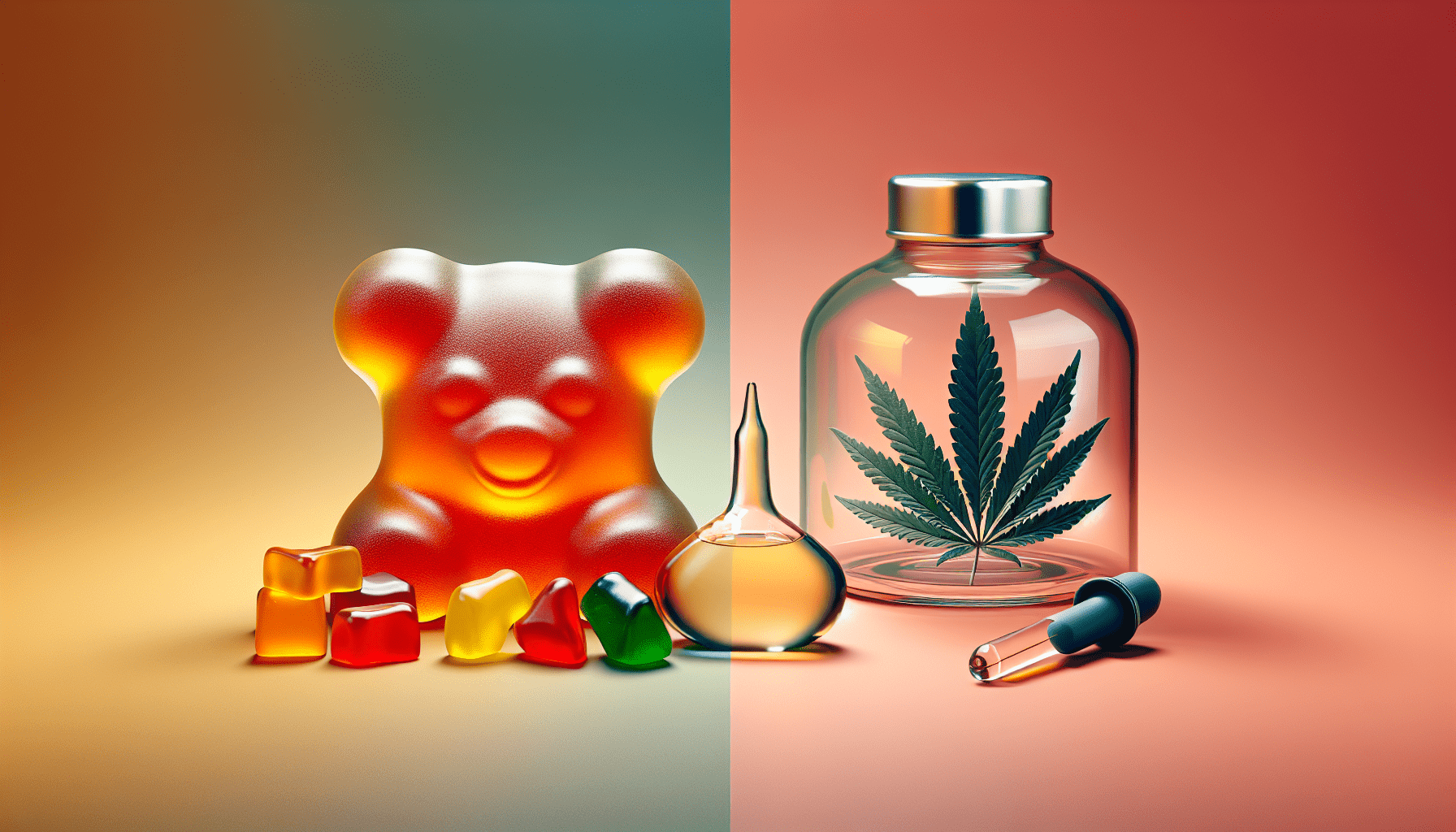So you’ve been hearing about the various ways to consume cannabis and now you’re curious about edibles and tinctures? Well, you’re in luck because in this article, we’ll be comparing these two popular cannabis products to help you make an informed decision. Whether you’re a newbie or a seasoned user, understanding the differences between edibles and tinctures can greatly impact your cannabis experience. So get ready to explore the world of cannabis-infused treats and liquid concoctions as we break down the characteristics, effects, and usage of edibles and tinctures.
Overview of Cannabis Edibles and Tinctures
Cannabis edibles and tinctures are popular forms of consumption for those seeking the benefits of cannabis without smoking it. Edibles refer to food products infused with cannabis, while tinctures are concentrated liquid extracts of cannabis. Both offer alternative methods of consumption that appeal to a wide range of individuals.
Definition of cannabis edibles
Cannabis edibles are food products that have been infused with cannabis extracts or oils. They come in various forms such as gummies, chocolates, and baked goods. Edibles provide a discrete and enjoyable way to consume cannabis, often replicating the taste and texture of regular food items.
Definition of cannabis tinctures
Cannabis tinctures, on the other hand, are liquid extracts of cannabis that are typically taken orally. They are made by soaking cannabis flowers or concentrates in a solution such as alcohol or oil. Tinctures offer a more precise and controlled dosage, making them a popular choice for individuals who prefer accurate dosing.
Introduction to their consumption methods
When it comes to consuming cannabis edibles, the most common method is simply eating them. These products are typically ingested and processed through the digestive system. Tinctures, on the other hand, can be consumed sublingually by placing a few drops under the tongue or added to beverages like tea or coffee. They can also be ingested directly by swallowing the liquid.
Benefits of Cannabis Edibles
Long-lasting effects
One of the key benefits of consuming cannabis edibles is the long-lasting effects they provide. When ingested, the cannabis compounds are metabolized by the liver, resulting in a slower and more prolonged release into the bloodstream. This translates to a sustained and consistent high that can last for several hours, providing a more extended period of relief for medical users.
Discreet consumption
Another advantage of cannabis edibles is the discreet nature of their consumption. Unlike smoking or vaping, which can produce smoke or strong odors, edibles offer a more low-key experience. They resemble regular food items, making it easier to consume in public or around others without drawing attention. This makes edibles a preferred option for individuals who value privacy and discretion.
Consistent dosing
Cannabis edibles provide a convenient way to achieve consistent dosing. The cannabis compounds are evenly distributed throughout the product, ensuring that each serving contains a specific amount of cannabinoids. This allows users to accurately control their dosage and customize their experience according to their desired effects. Consistent dosing is particularly beneficial for medical users who rely on precise and predictable cannabinoid intake.
Drawbacks of Cannabis Edibles
Delayed onset
While cannabis edibles offer long-lasting effects, they also come with a drawback – a delayed onset of action. When consumed orally, the cannabinoids must travel through the digestive system, undergo metabolism, and be absorbed into the bloodstream. This process can take anywhere from 30 minutes to two hours, resulting in a slower onset of effects compared to other consumption methods. This delayed onset can catch some individuals off guard and lead to overconsumption if they don’t exercise patience.
Overconsumption risks
One of the biggest pitfalls of cannabis edibles is the risk of overconsumption. Because the effects of edibles take longer to kick in, some individuals may be tempted to consume additional servings in the belief that they haven’t taken enough. However, this can lead to an overwhelming and uncomfortable experience once the effects finally set in. It’s crucial to exercise caution and practice patience when consuming edibles to avoid unwanted side effects.
Limited dosage control
While consistent dosing is a benefit of cannabis edibles, it also presents a potential drawback. Each serving size of an edible typically contains a predetermined amount of cannabinoids. This means that adjusting the dosage can be challenging, especially for individuals who require smaller or larger amounts of cannabis. It’s essential to choose edibles with the desired potency to ensure that the dosage aligns with individual needs.
Benefits of Cannabis Tinctures
Faster onset
One of the significant advantages of cannabis tinctures is their faster onset of effects compared to edibles. When administered sublingually, the cannabinoids in the tincture are absorbed directly into the bloodstream through the mucous membranes under the tongue. This allows for a more rapid onset of effects, usually within 15 to 30 minutes. This quick response time makes tinctures an appealing option for those seeking immediate relief or fast-acting effects.
Precise dosage control
Cannabis tinctures offer unparalleled dosing accuracy and control. They are usually packaged with dropper caps, allowing users to measure out the desired amount of tincture. This precise dosing mechanism enables individuals to titrate their intake to find the optimal dosage for their needs. Whether it’s starting with a small dose and gradually increasing or finding the right amount for specific symptom relief, tinctures provide the flexibility to tailor the dosage to individual preferences.
Lower calorie intake
For individuals who are mindful of their caloric intake, cannabis tinctures can be a preferred choice over edibles. While edibles often contain additional ingredients like sugar, butter, or oil, tinctures are primarily made up of cannabis extract and a carrier liquid. This means that consuming tinctures does not involve consuming unnecessary calories. Tinctures are an excellent option for those looking to incorporate cannabis into their wellness routine without the added caloric burden.
Drawbacks of Cannabis Tinctures
Potential undesired taste
One potential drawback of cannabis tinctures is the taste. Some individuals may find the flavor of cannabis tinctures unpleasant or bitter. While efforts have been made to enhance the taste with added flavors or natural ingredients, the underlying taste of cannabis may still be present. This can be a deterrent for individuals who are sensitive to tastes or for those who prefer a more enjoyable consumption experience.
Alcohol content concerns
Many cannabis tinctures are made using alcohol as the solvent for extracting the cannabinoids. This can be a concern for individuals who are sensitive to alcohol or those who wish to avoid it altogether. While the alcohol content in tinctures is typically low, it’s essential to be mindful of any potential interactions or negative effects that alcohol may have on an individual’s health. It may be necessary to seek alcohol-free tincture options or explore other consumption methods for those with alcohol sensitivities.
Less discreet consumption
Compared to edibles, the consumption of cannabis tinctures is typically less discreet. While the act of taking a drop under the tongue can be done discreetly in private, it may be noticeable to others in certain situations. This can limit the use of tinctures in public or around individuals who may not be aware of or comfortable with cannabis consumption. It’s important to consider the level of discretion required and the potential impact on personal comfort when choosing between tinctures and other consumption methods.
Different Methods of Administration
Edibles: Gummies, chocolates, baked goods
Cannabis edibles come in various forms, providing a wide range of options for individuals to choose from. Gummies, chocolates, and baked goods are some of the most popular edible choices on the market. These products often resemble their non-infused counterparts, making them easily recognizable and accessible to both experienced users and newcomers to cannabis.
Tinctures: Sublingual, added to beverages, ingested
Cannabis tinctures also offer versatility in terms of administration methods. Sublingual administration, where a few drops are placed under the tongue, is the most common and efficient way to use tinctures. However, tinctures can also be added to beverages like tea or coffee, allowing for a convenient and discreet way of consumption. For those who prefer a more straightforward approach, tinctures can be ingested directly by swallowing the liquid.
Effects and Duration
Edibles: Slow onset, longer duration
Edibles are known for their slower onset of effects compared to other consumption methods. It typically takes between 30 minutes to two hours for the effects to be felt, as the cannabinoids are digested and metabolized by the liver. Once the effects kick in, they tend to last much longer compared to inhalation methods, with the high often lasting for four to six hours or more. The slow onset and extended duration of edibles make them ideal for individuals seeking sustained relief or a longer-lasting cannabis experience.
Tinctures: Faster onset, shorter duration
In contrast to edibles, cannabis tinctures offer a faster onset of effects. When administered sublingually, the cannabinoids bypass the digestive system and are quickly absorbed into the bloodstream. This results in effects that are felt within 15 to 30 minutes. However, the duration of tincture effects tends to be shorter compared to edibles, typically lasting around two to four hours. Tinctures are an excellent option for individuals looking for quicker relief or a more controllable cannabis experience with a shorter duration.
Dosage and Dosing
Edibles: Varying potency per serving, delayed effects
One challenge with cannabis edibles is the variability in potency per serving. Different edible products can have varying levels of cannabinoids, making it essential to read the packaging and understand the dosage per serving. Additionally, the delayed onset of effects can make it difficult to gauge the appropriate dosage. It’s crucial to start with a low dose and wait for the effects to kick in before consuming more to avoid overconsumption and unwanted side effects.
Tinctures: Precise dropper measurements, quicker effects
Cannabis tinctures offer a precise dosing mechanism, thanks to the dropper caps that accompany the packaging. This allows for accurate measurements, making it easier to control the dosage and titrate the intake based on individual needs. Tinctures also provide a faster onset of effects, enabling users to gauge the impact and adjust the dosage accordingly. The combination of precise dropper measurements and quicker effects makes tinctures a popular option for those who prioritize accurate dosing and quicker relief.
Regulatory Environment
Edibles: Complex regulations on packaging, labeling, and dosages
The regulatory landscape surrounding cannabis edibles can be complex. Health and safety regulations often dictate the packaging, labeling, and dosages of edible products. It’s essential for manufacturers to comply with these regulations to ensure consumer safety and to provide accurate information to users. The rigorous oversight ensures that edibles are produced and distributed responsibly, allowing consumers to make informed decisions about their consumption.
Tinctures: Similar regulations to liquid medications
Cannabis tinctures, especially those sold as medical products, are subject to similar regulations as liquid medications. These regulations govern aspects like labeling requirements, quality control, and safety standards. By adhering to these regulations, tincture manufacturers ensure that their products meet the necessary standards for consumer use. The regulations help to establish trust and confidence in the quality and safety of cannabis tinctures.
Choosing between Edibles and Tinctures
Considerations for desired effects
When choosing between cannabis edibles and tinctures, it is essential to consider the desired effects. Edibles provide a more prolonged and sustained experience, making them suitable for individuals seeking long-lasting relief or a mellow high. On the other hand, tinctures offer quicker relief and a shorter duration of effects, making them a better fit for those who prefer more immediate and controllable experiences.
Individual preferences and sensitivities
Personal preferences and sensitivities should also be taken into account when deciding between edibles and tinctures. Some individuals may have dietary restrictions or preferences that make edibles a more favorable option, while others may be sensitive to tastes or alcohol content, leading them to lean towards tinctures. Considerations such as taste, calorie intake, and ingredient preferences can help determine which method of consumption aligns best with individual needs and preferences.
Lifestyle factors and convenience
Lifestyle factors and convenience should also be considered. If discretion is a priority, edibles may be a better choice due to their more discrete nature. Conversely, if immediate relief is required, tinctures offer a faster onset of effects that better align with an individual’s lifestyle. Additionally, the ease of use and portability of each method should be taken into account to ensure that the chosen consumption method seamlessly integrates into daily routines.
In conclusion, cannabis edibles and tinctures offer individuals alternative methods of consuming cannabis without smoking. Edibles provide long-lasting effects, discreet consumption, and consistent dosing, while tinctures offer a faster onset, precise dosage control, and lower calorie intake. Each method has drawbacks, such as delayed onset and overconsumption risks with edibles and potential undesired taste and alcohol content concerns with tinctures. The choice between edibles and tinctures depends on factors such as desired effects, individual preferences and sensitivities, and lifestyle factors. Ultimately, selecting the right method of consumption is a personal decision that should be based on individual needs and preferences.




